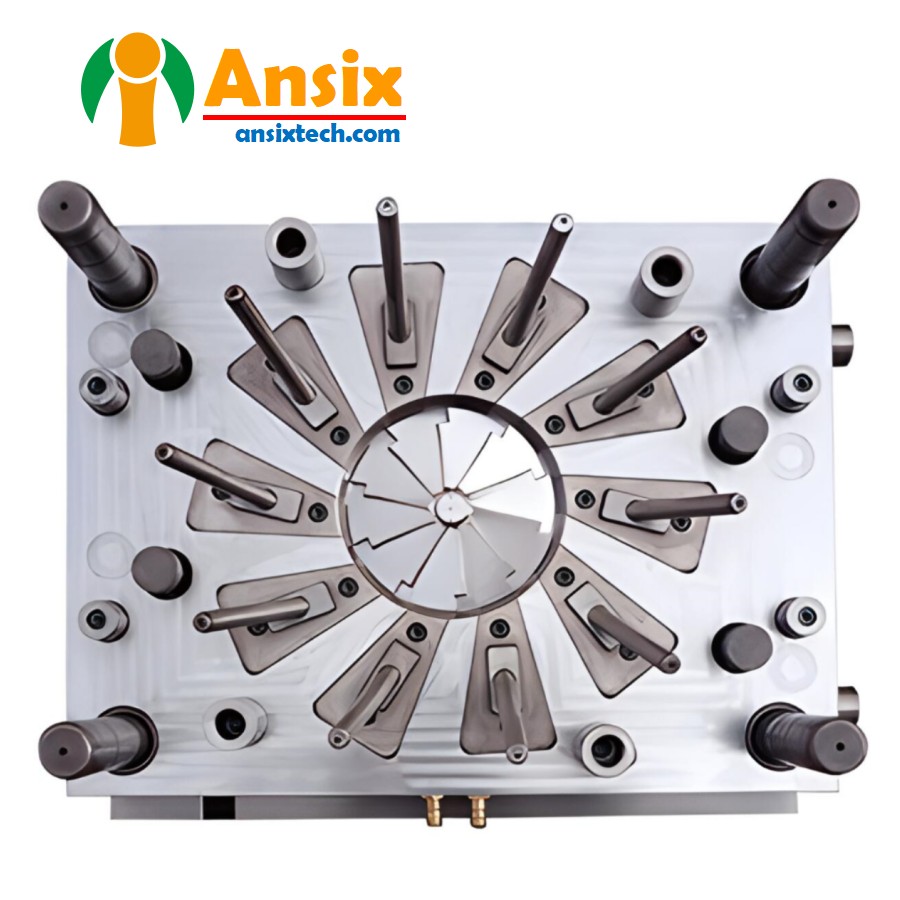Precision Plastic Impeller mold Turbine blades Injection Mold Fan plastic injection molding
FEATURES
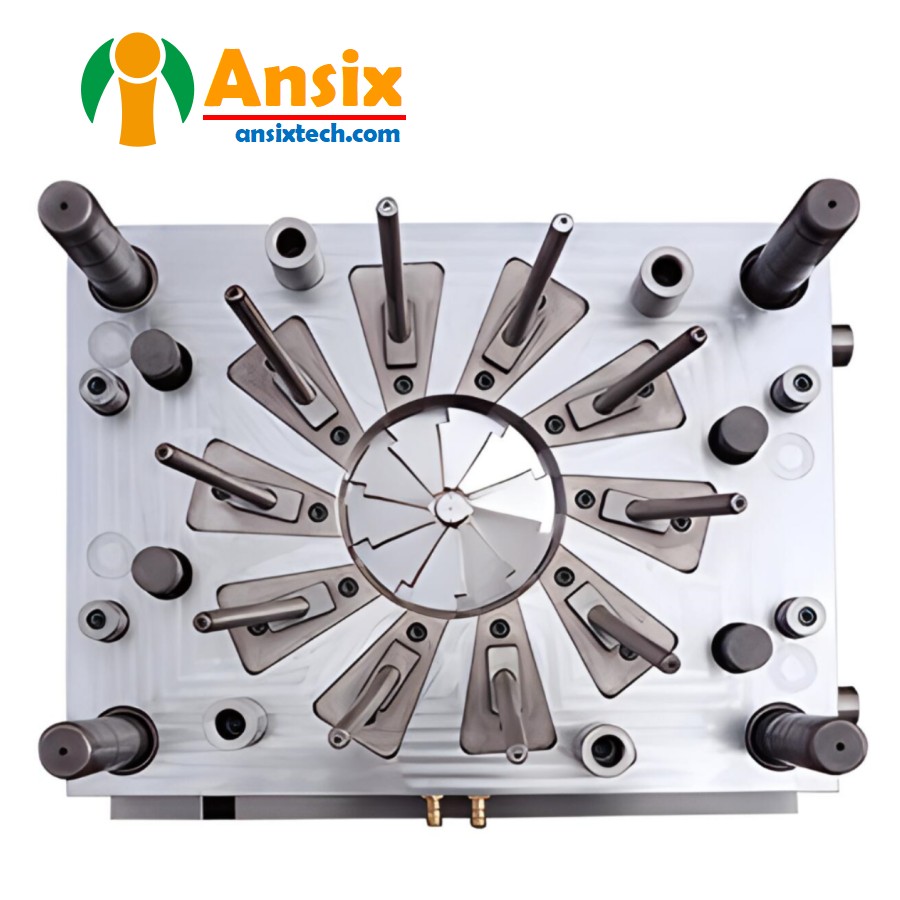
- About AnsixTech fan blade application areas
1. Large industrial equipment fan blade moldIndustrial fan blade mold is a mold used to manufacture industrial fan blades. It is a key tool in the industrial fan blade manufacturing process, used to process raw materials (such as metal or plastic) into blades with specific shapes and sizes.Manufacturing fan blades: Industrial fan blade molds are used to process metal or plastic raw materials into the shape of fan blades. The mold usually consists of two or more parts. Through the opening, closing and pressure of the mold, the raw material is injected into the mold. After cooling and solidification, the shaped fan blade is obtained.Customized design: Industrial fan blade molds can be customized and designed according to customer needs. Depending on the fan model, size and shape requirements, the mold manufacturer can manufacture a fan blade mold that meets the requirements based on the design drawings or samples provided by the customerMass production: Industrial fan blade molds can achieve mass production. Once the mold is manufactured, a large number of blades can be produced quickly and efficiently through mold injection or stamping processes to meet market demand.Quality control: The application of industrial fan blade molds also includes quality control. During the manufacturing and use of molds, strict quality control and testing are required to ensure that the dimensional accuracy, surface quality and performance of the fan blades meet the requirements. The application of industrial fan blade molds can improve the production efficiency and consistency of blades, and can also meet the personalized needs of different customers. It plays an important role in the industrial fan manufacturing industry.
- Automotive cooling fan blade mold
Automobile cooling fan blade mold is a mold used to manufacture automobile cooling fan blades. The automobile cooling fan is an important part of the automobile engine cooling system and is used to provide cooling air flow to reduce engine temperature. The blade is a key component of the cooling fan, and its design and manufacturing are crucial to the performance and effectiveness of the cooling system.Manufacturing fan blades: Automotive cooling fan blade molds are used to process metal or plastic raw materials into the shape of the fan blades. The mold usually consists of two or more parts. Through the opening, closing and pressure of the mold, the raw material is injected into the mold. After cooling and solidification, the shaped fan blade is obtained.Customized design: Automobile cooling fan blade molds can be customized and designed according to the needs of automobile manufacturers. According to different car models, size and shape requirements, mold manufacturers can manufacture fan blade molds that meet the requirements based on the design drawings or samples provided by customers.Mass production: Automotive cooling fan blade molds can achieve mass production. Once the mold is manufactured, large quantities of blades can be produced quickly and efficiently through mold injection or stamping processes to meet the needs of automobile manufacturers.Quality control: The application of automotive cooling fan blade molds also includes quality control. During the manufacturing and use of molds, strict quality control and testing are required to ensure that the dimensional accuracy, surface quality and performance of the fan blades meet automotive manufacturing standards and requirements.The application of automotive cooling fan blade molds can improve the production efficiency and consistency of the blades, while also meeting the individual needs of automobile manufacturers. It plays an important role in the automobile manufacturing industry, ensuring the normal operation and cooling effect of the engine. 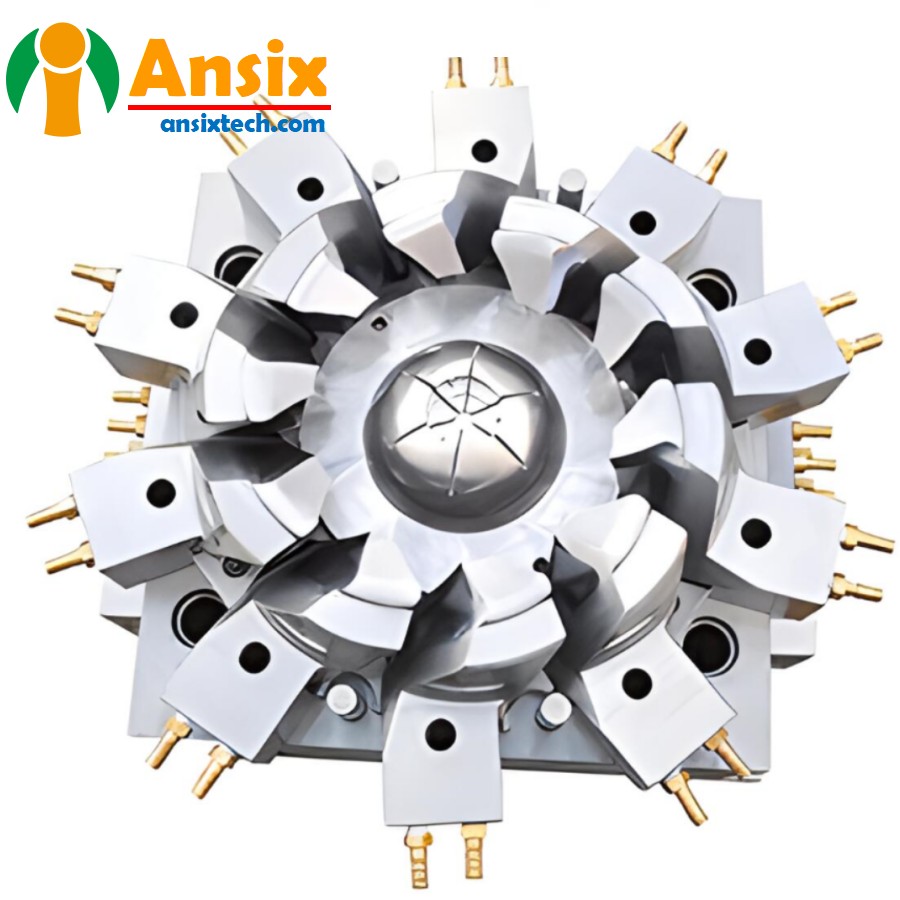

- New energy bus air conditioning cooling fan blade mold
The new energy bus air conditioning fan blade mold is a mold used to manufacture the fan blades in the new energy bus air conditioning system. New energy buses refer to public transportation vehicles driven by new energy technologies (such as electricity, hybrid power, etc.). Their air conditioning systems need to be equipped with corresponding fan blades to achieve air circulation and adjust temperature.Manufacturing fan blades: New energy bus air conditioner fan blade molds are used to process metal or plastic raw materials into the shape of fan blades. The mold usually consists of two or more parts. Through the opening, closing and pressure of the mold, the raw material is injected into the mold. After cooling and solidification, the shaped fan blade is obtained.Customized design: New energy bus air conditioning fan blade molds can be customized and designed according to customer needs. According to different bus models, air conditioning system requirements, air flow and other parameters, mold manufacturers can manufacture fan blade molds that meet the requirements based on the design drawings or samples provided by customers.Mass production: New energy bus air conditioner fan blade molds can achieve mass production. Once the mold is manufactured, a large number of blades can be produced quickly and efficiently through mold injection or stamping processes to meet the needs of new energy bus manufacturers.Quality control: The application of new energy bus air conditioning fan blade molds also includes quality control. During the manufacturing and use of molds, strict quality control and testing are required to ensure that the dimensional accuracy, surface quality and performance of the fan blades meet the requirements.The application of new energy bus air conditioning fan blade molds can improve the production efficiency and consistency of the fan blades, and can also meet the personalized needs of new energy bus manufacturers. It plays an important role in the new energy bus manufacturing industry, ensuring the normal operation and comfort of the air conditioning system.
- Car water tank cooling fan blade mold Exhaust fan exhaust fan blade mold
The automobile water tank cooling fan blade mold is a mold used to manufacture the fan blades in the automobile water tank cooling system. The car water tank cooling fan blade is an important part of the car cooling system. It is used to increase air flow, improve heat dissipation effect, and ensure the normal operating temperature of the engine.Manufacturing fan blades: Car water tank cooling fan blade molds are used to process metal or plastic raw materials into the shape of fan blades. The mold usually consists of two or more parts. Through the opening, closing and pressure of the mold, the raw material is injected into the mold. After cooling and solidification, the shaped fan blade is obtained.Customized design: The automobile water tank cooling fan blade mold can be customized and designed according to the needs of the automobile manufacturer. According to different car models, water tank cooling system requirements, air flow and other parameters, mold manufacturers can manufacture fan blade molds that meet the requirements based on the design drawings or samples provided by customers.Mass production: The automobile water tank cooling fan blade mold can achieve mass production. Once the mold is manufactured, large quantities of blades can be produced quickly and efficiently through mold injection or stamping processes to meet the needs of automobile manufacturers.Quality control: The application of automobile water tank cooling fan blade mold also includes quality control. During the manufacturing and use of molds, strict quality control and testing are required to ensure that the dimensional accuracy, surface quality and performance of the fan blades meet automotive manufacturing standards and requirements.The application of automobile water tank cooling fan blade mold can improve the production efficiency and consistency of the fan blades, and can also meet the personalized needs of automobile manufacturers. It plays an important role in the automobile manufacturing industry, ensuring the normal operation and heat dissipation of the engine. 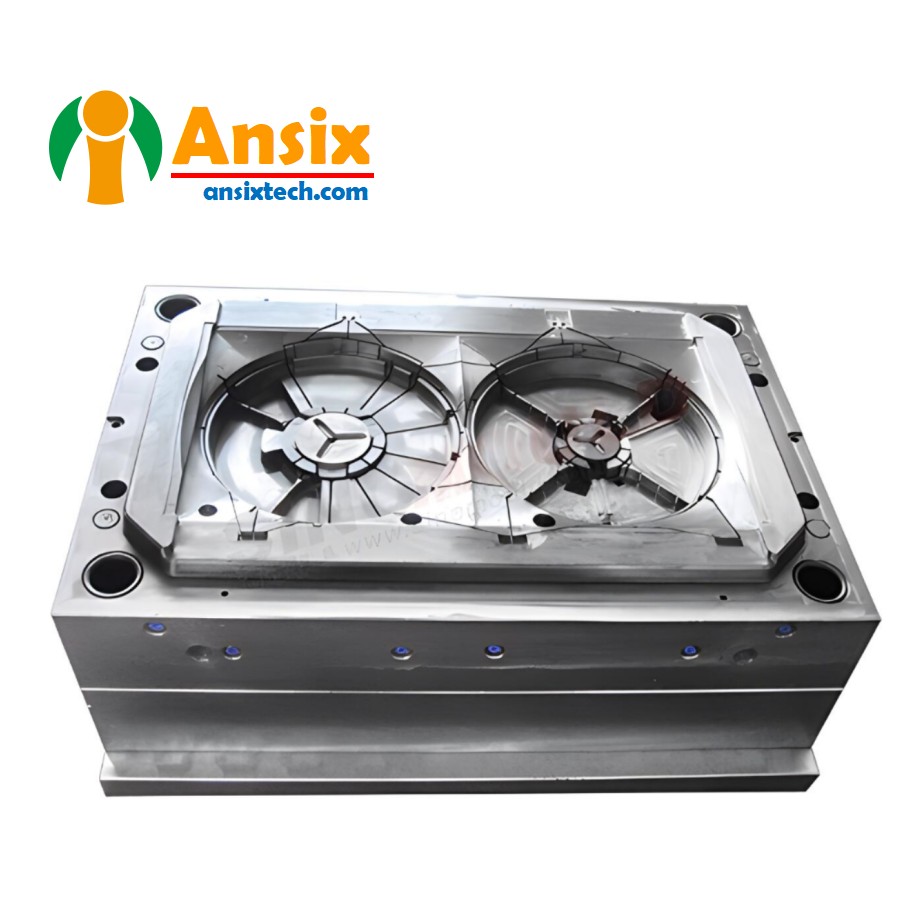
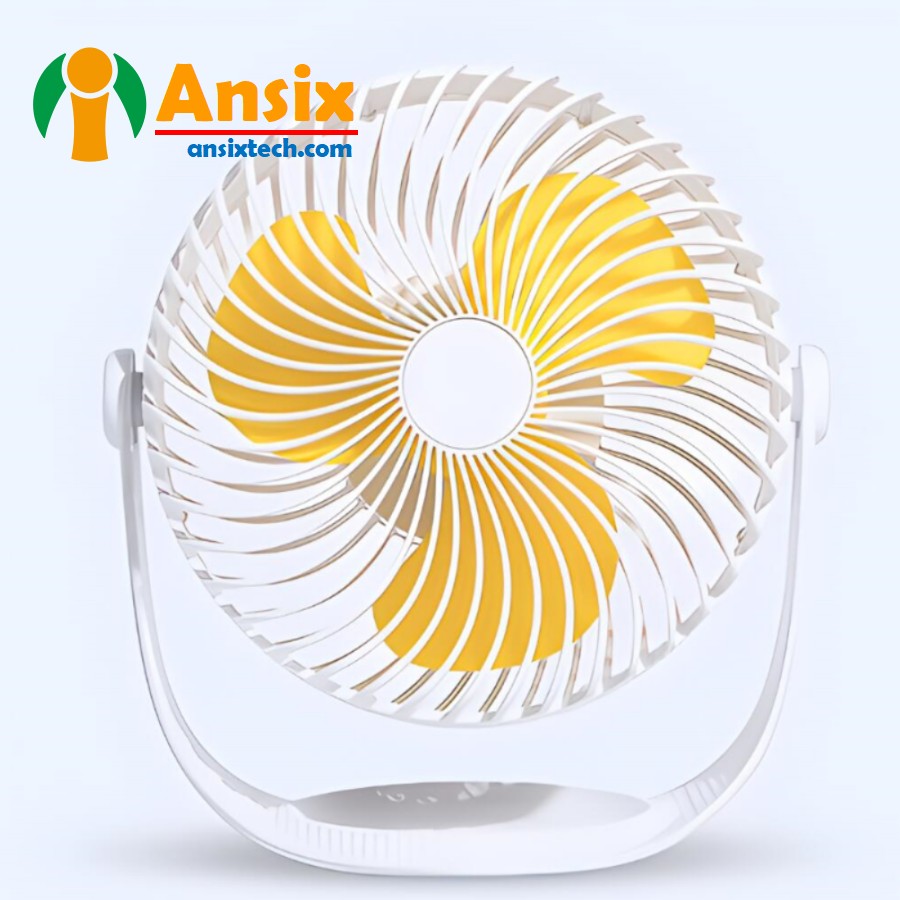
- Countertop small fan blade mold
The blade mold of a small household countertop fan is a mold used to manufacture the blades of a small household countertop fan. Small household countertop fans are a common household appliance used to provide ventilation and cooling to individuals or small areas.Manufacturing fan blades: Small household countertop fan blade molds are used to process metal or plastic raw materials into the shape of fan blades. The mold usually consists of two or more parts. Through the opening, closing and pressure of the mold, the raw material is injected into the mold. After cooling and solidification, the shaped fan blade is obtained.Customized design: The small household countertop fan blade mold can be customized and designed according to customer needs. According to different fan models, sizes and shape requirements, mold manufacturers can manufacture blade molds that meet the requirements based on the design drawings or samples provided by customers.Mass production: The small household countertop fan blade mold can be mass produced. Once the mold is manufactured, a large number of blades can be produced quickly and efficiently through mold injection or stamping processes to meet market demandQuality control: The application of small household countertop fan blade molds also includes quality control. During the manufacturing and use of molds, strict quality control and testing are required to ensure that the dimensional accuracy, surface quality and performance of the fan blades meet the requirements.The application of small household countertop fan blade molds can improve the production efficiency and consistency of the fan blades, and at the same time, it can also meet market demand and the personalized needs of consumers. It plays an important role in the home appliance manufacturing industry, providing people with a comfortable ventilation experience.
- Household vertical fan blade mold
Household vertical fan blade mold manufacturing is a mold used to manufacture the fan blades in household vertical fans. Household vertical fans are a common household appliance used to provide indoor ventilation and cooling.Design: Carry out mold design according to the fan blade design requirements provided by the customer, including the shape, size, material, etc. of the fan blade.Mold manufacturing: According to the design drawings, use CNC machine tools and other equipment to manufacture molds, including cutting, milling, drilling and other processes.Heat treatment: Heat treatment is performed on the manufactured mold to improve the hardness and wear resistance of the mold.Assembly and debugging: Assemble the various parts of the mold and debug them to ensure the normal operation of the mold.Mold trial: Use the mold to trial the mold to check the molding effect and quality of the fan blades.Correction and improvement: Based on the mold trial results, the mold will be corrected and improved to improve the molding effect and quality of the fan blades.Production: After mold trial and improvement, mass production will begin to manufacture household vertical fan blades that meet customer requirements.The manufacturing of household vertical fan blade molds requires certain skills and experience to ensure the quality and performance of the molds. At the same time, according to different fan blade design requirements, the manufacturing of molds also needs to be customized to meet customer needs. Manufacturing high-quality fan blade molds can ensure the performance and service life of household vertical fans. 

- Outdoor small fan blade mold
Outdoor smart micro fan blade manufacturing is a process used to manufacture the blades in outdoor smart micro fans. The outdoor smart micro fan is a portable fan device suitable for outdoor activities, travel and other occasions to provide personal ventilation and cooling.Design: Design the fan blades according to product demand and market demand, including shape, size, material, etc.Material selection: According to the design requirements, select suitable materials for manufacturing. Common materials include plastic, metal, etc.Mold manufacturing: According to the design drawings, the mold of the fan blade is manufactured. The mold usually consists of two or more parts. Through the opening, closing and pressure of the mold, the raw material is injected into the mold. After cooling and solidification, the shaped fan blade is obtained.Injection molding or stamping: Use a mold for injection molding or stamping to process the raw materials into the shape of the fan blades.Quality control: Strict quality control and testing are carried out during the manufacturing process to ensure that the dimensional accuracy, surface quality and performance of the fan blades meet the requirements.Assembly and testing: Assemble the manufactured blades into a miniature fan and conduct testing to ensure the normal operation and performance of the fan.The manufacturing of outdoor smart micro fan blades requires certain technology and experience to ensure the quality and performance of the blades. At the same time, according to product design requirements, fan blades that meet market demand are manufactured to provide good ventilation and cooling effects. Manufacturing high-quality fan blades can improve the performance and service life of outdoor smart mini fans.
- Mold Marking Process
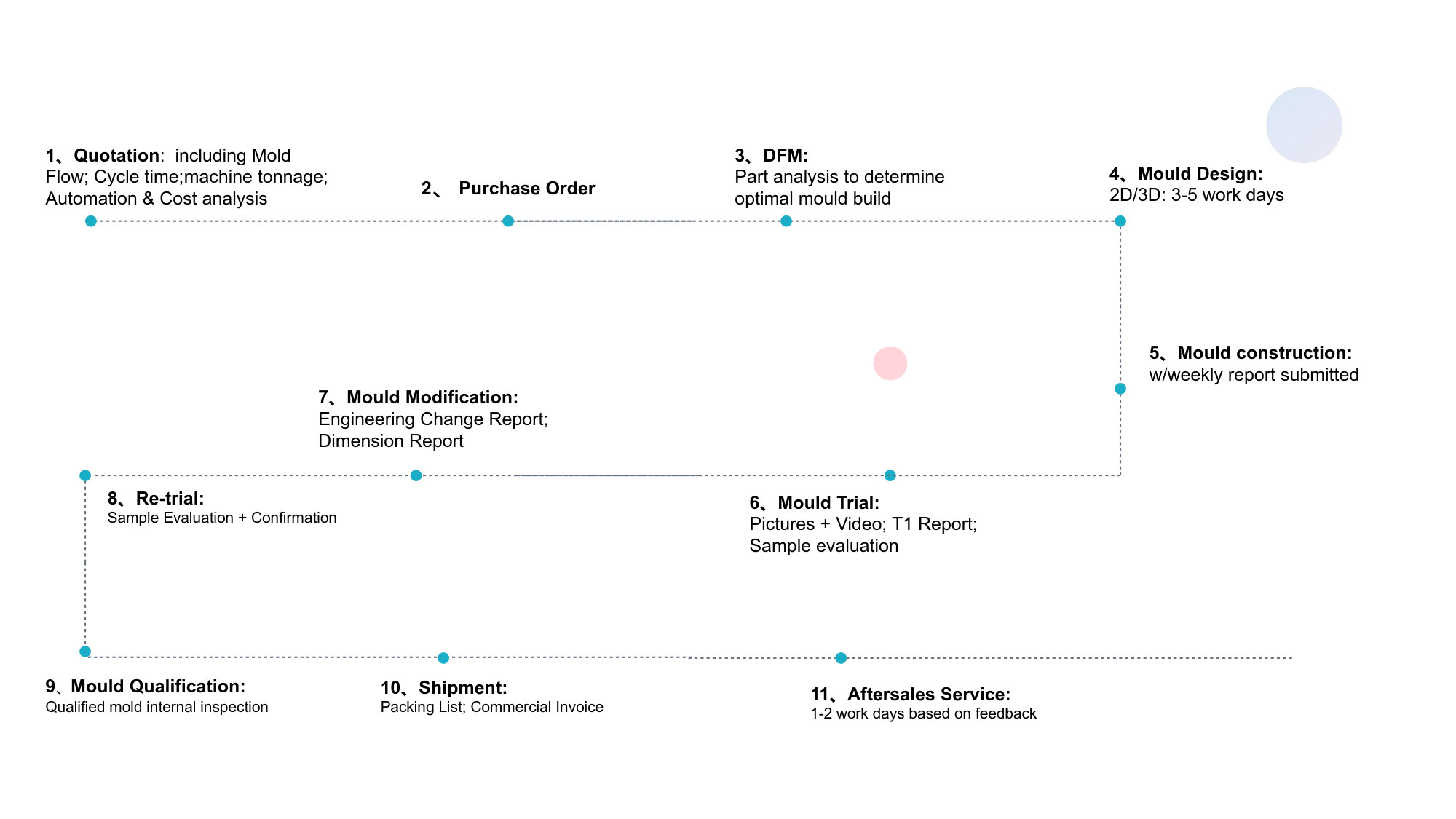
-
Precision Impeller Mold and Turbine blades mold Fan mold Mold flow analysis and mold design
Mold flow analysis and mold design of turbine blades and electric fan blade molds:
Mold design:
According to the design requirements of turbine blades and electric fan blades, determine the structure of the mold, including mold cavity, mold core, demoulding system, cooling system, etc.
Ensure that the accuracy and size of the mold meet the requirements to ensure the quality and stability of injection molding.
Consider the durability and ease of maintenance of the mold, and rationally design the structure and parts of the mold to improve the life and ease of maintenance of the mold.
Mold flow analysis:
Use mold flow analysis software to import the CAD models of turbine blades and electric fan blades, and set injection molding process parameters, such as injection speed, temperature, pressure, etc.
Conduct mold flow analysis to simulate melt flow, filling, cooling and other processes during the injection molding process to evaluate filling performance, bubbles, short shots and other defects, and optimize injection molding process parameters.
During the mold design and mold flow analysis process, you need to pay attention to the following points:
Ensure filling performance: Through mold flow analysis, the injection molding process parameters are optimized to ensure good filling performance and avoid defects.
Design of cooling system: Reasonably design the cooling system to ensure good cooling effect during the injection molding process and improve production efficiency and product quality.
Design of demoulding system: According to the shape and requirements of turbine blades and electric fan blades, design a suitable demoulding system to ensure that the blades can be demoulded smoothly and avoid damage and deformation.
Injection molding sequence and injection point location: Determine the injection sequence and injection point location to ensure that the plastic material can fully fill the mold cavity and avoid voids and defects.
Through reasonable mold design and mold flow analysis, high-quality turbine blades and electric fan blade molds can be obtained. Please note that mold design and mold flow analysis require professional knowledge and experience. It is recommended to cooperate with a professional mold design and mold flow analysis team to ensure the accuracy and reliability of design and analysis.
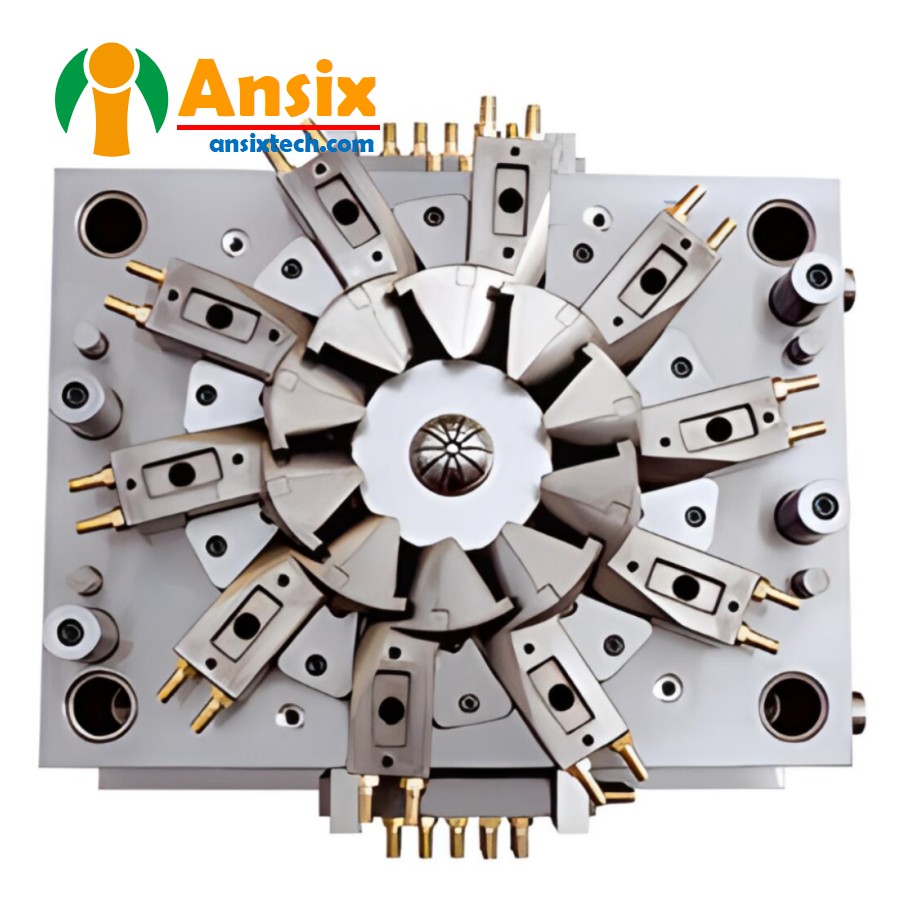
- Precision Impeller Mold and Turbine blades mold Fan mold of the mold manufacturing process and product material selectionThe manufacturing and processing of turbine blades and electric fan blade molds and the selection and application of blade materials:Mold manufacturing and processing:According to the mold design, select appropriate processing technology and equipment, such as CNC machining center, EDM machine, etc.Processing of mold parts, including mold cavity, mold core, demoulding system, cooling system, etc. Ensure that the processing accuracy and size meet the requirements.Assemble mold parts to ensure accurate fit and adjustment of parts and ensure the stability and reliability of the mold.Fan blade material selection:Select appropriate injection molding materials according to the requirements of turbine blades and electric fan blades. Commonly used materials include polypropylene (PP), polycarbonate (PC), etc.Polypropylene (PP) has good toughness and wear resistance, is suitable for the manufacture of wind blades, and can meet the strength and durability requirements of the product.Polycarbonate (PC) has good strength, rigidity and heat resistance. It is suitable for the manufacture of wind blades and can meet the strength and durability requirements of the product.During the mold manufacturing process and fan blade material selection and application process, the following points need to be noted:Processing accuracy and size control: Ensure that the processing accuracy and size of mold parts meet the requirements to ensure the quality and stability of injection molding.Surface treatment of the mold: According to the requirements of the turbine blades and electric fan blades, carry out appropriate surface treatment, such as grinding, polishing, etc., to improve the surface quality and smoothness of the blades.Control of injection molding process parameters: According to the characteristics of the material, reasonably design and control the injection molding process parameters to ensure that the filling performance and curing effect of the material meet the requirements.Material selection and certification: Select injection molding materials that meet relevant standards and certification requirements to ensure product safety and hygiene.The manufacturing and processing of turbine blades and electric fan blade molds has the advantages of efficient production, precision control, multi-functional design and cost saving. When selecting blade materials, factors such as strength, heat resistance, and wear resistance need to be considered. Through reasonable processing and material selection, high-quality wind blade production can be achieved. It is recommended to work with professional mold manufacturing and injection molding material suppliers to ensure accuracy and reliability of manufacturing and selection.
- Precision Impeller Mold and Turbine blades mold Fan mold Mass production and Quality controlTo achieve mass production of turbine blades and electric fan blades and ensure tooling, production efficiency, cost control and quality assurance:Work fixture design:According to the shape and requirements of turbine blades and electric fan blades, design appropriate fixtures to fix and position the blades to ensure accuracy and consistency in processing and assembly.The design of the tooling fixture should consider ease of operation, stability and adjustability to adapt to the production of blades of different specifications and models.Improvement of production efficiency:Automated production equipment: Use automated injection molding machines and robotic systems to achieve automated production, reduce manual operations and improve production efficiency.Optimize production process: Reduce non-production time and improve production efficiency by optimizing production planning, material supply chain and process flow.Cost control:Material cost control: Select appropriate injection molding materials, balance material performance and cost based on product requirements and cost considerations.Mold cost control: optimize mold design and manufacturing to reduce mold manufacturing costs. You can consider using standard mold parts, mold sharing, etc. to reduce mold costs.Production process optimization: Reduce production costs by optimizing injection molding process parameters, reducing scrap rates, and increasing production speed.Quality assurance:Establish a complete quality control system, including quality inspection, process control and defective product processing, to ensure that products meet quality standards.Conduct inspections and tests on product appearance quality, dimensional accuracy, physical properties, etc. to ensure product quality and consistency.Monitor injection molding process parameters and key control points in the production process, and make timely adjustments and optimizations to ensure the stability and consistency of the production process.Through reasonable tooling and fixture design, production efficiency improvement, cost control and quality assurance measures, mass production of turbine blades and electric fan blades can be achieved and the quality and consistency of the products can be ensured. It is recommended to work with a professional mold manufacturing and injection molding processing team to ensure accuracy and reliability of manufacturing and processing. At the same time, it is recommended to cooperate with the quality management team to establish a complete quality control system to ensure product quality and consistency.


